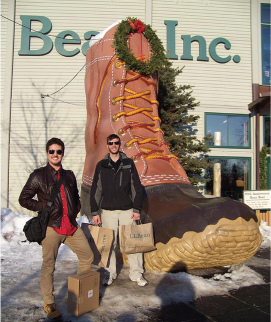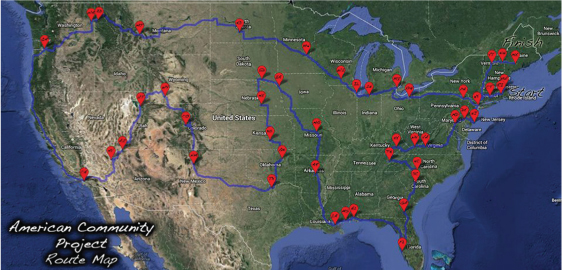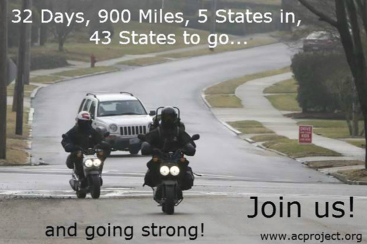Is it time for credit unions to change the lens on how to help serve the underserved?
For Dan Emery, former marketing specialist at the $346 million Maine State Credit Union in Augusta, the answer is yes, why not?
“I think credit unions have tremendous opportunities and potential available to them by getting involved with projects like community gardens, school gardens or helping to promote Community Supported Agriculture programs,” he said.

Good thing Emery (right) and Chung loaded up on warm gear, since they started their journey in Connecticut on Jan. 8.
Citing Maslow's Hierarchy of Needs, Emery added that while money and its related services falls within the second level of safety, food is at the base of the pyramid.
“If we are trying to improve the quality of life in our communities, build our membership, secure their financial health, and serve those underserved, we can do all of these things by helping people secure their basic needs,” said Emery.
“We will not only increase the quality of life for those within our community, but we’ve now opened our doors to an entirely new membership base.
“By showing them that we are more than a financial institution and by showing them that we want their business because it means we can help make improvements that directly affect them and their family, this is how we begin to build loyalty.”
His belief that no one should go hungry and everyone should have access to fresh healthy food is so strong, that in 2012, he founded the American Community Project, as a way to raise awareness and funds for agriculture-based hunger solutions.
This year, Emery and a friend, Myles Chung, have taken the ACP on the road. The duo will be exploring local community projects addressing hunger needs in 48 states for 48 weeks on mopeds. The goal? Simply to gather ideas, raise awareness and $1 million to be split among the organizations visited.
Emery said this could include school and community gardens, urban farms, seed initiatives, waste reduction or distribution projects, or other community projects that help bring fresh, healthy fruits and vegetables to those who need it most.
The ties of hunger and poverty to homelessness have fascinated Emery since a trip to Paraguay in 2003. Every day for two months he’d see children as young as 5 at busy intersections begging, offering to wash car windows or selling miscellaneous items for a few coins.
One night on the way he gave a box of pizza to some children hanging around a store. His friend explained that while the intention was good, it actually put a target on the kids, who might well be beat up for the food.
“That shocked me. I never experienced anything like that before and it made me question the impact and solution of just giving someone food,” said Emery. “Was that really the best way to help people who are hungry?”
His search for the answer continued for the next 10 years. In 2006, he joined the Maine State CU social responsibility committee, which focused primarily on ending hunger and in 2011, he served on the Augusta City Council.

This map shows the American Community Project route across 48 states in 48 weeks.
During his two and a half years on the council he witnessed how education, crime, poverty, hunger, mental and physical health, the economy and quality of life together and affected the community.
Since 1990, credit unions in Maine have invested some $5.3 million into ending hunger initiatives. Yet, over the past five years food insecurity has grown from 12% of households to 15%. Emery wanted to get to the root of the issue while uncovering ways to make a positive, long-lasting change.
“The key questions we’re asking are: What are the challenges? What is being done to solve these problems? What are the most efficient and effective solutions? Can they be shared with or implemented within other communities,” said Emery. He said he got the hunger tour idea after what would turn out to be his last visit with his godmother, who’d been battling pancreatic cancer.
“I was thinking about life and all those things you tend to reflect upon in this kind of situation, and I decided I wanted to do something different. I enjoyed my work, but I wanted to do more. Once the inspiration hit, the brainstorming and planning began.”

Emery and Chung and their Honda Ruckus scooters hit the road.
With his City Council term up in December 2013, he had 22 months to save, plan and raise funds for the experience of a lifetime. Maine State CU provided a $5,000 donation to help launch the project and allowed Emery to post information and promote it through its Facebook page and website.
The duo typically spends three to six days in each location and on travel days average about 80 to 150 miles on their Honda Ruckus scooters. As temperatures finally warm up, they plan to cover 200-250 miles a day. They stay on back and state roads as a way to get more familiar with the communities they travel through.
“We wanted a non-typical cross country vehicle that's great on gas mileage,” said Emery of the scooters. “Besides they are a lot of fun to ride.”
Emery and Chung stay with friends, family, Rotary Club contacts or those in the CouchSurfing network. They also have a tent for nights lodging can't be found.
Having only raised $16,000 of the $30,000 budgeted for travel, meant Emery and Chung while exploring hunger and food insecurity would be experiencing food insecurity themselves.
“The mental aspect of this trip has been the most difficult,” Emery said. “The lack of security relating to our food and housing is almost always on our minds and the weather has been pretty rough at times.”
The first day it was 11 below zero and most of their travel days so far have been in freezing temperatures or in the 30s. As for the fundraising portion of their project, so far $25,000 has been raised.
“Now that we are getting more comfortable with logistics and operating within our nomadic circumstances, fundraising is moving up on our action list,” said Emery. “When it comes to those who are looking for food there are consistencies in what they want, and it's quite simple. Most people just want an opportunity. If they can find a way to contribute and make a living for themselves, that's all they’re asking.”
He added that credit unions, local farms and CSAs have much in common. Whether it's providing greenhouse loans, farm stand and small farm loans, or planting a garden on their property to help benefit staffers, a food bank or local school, the possibilities for credit unions to help beat hunger are unlimited.
“If we think about our place in the financial industry, we exist for more than just the products we supply. We exist because of our community, and to serve and help strengthen our community. We play a very important role in the success or failure of our local economies and in our community's quality of life,” said Emery.
“Unemployment is nothing more than the state of temporary job-related irrelevance. By helping people identify and enhance their skills and abilities, we can help them find their relevance, get a job, find a career or start a business,” he said
“Building community, collaborating, working together for common goals – this is how we do it. It may seem difficult at first, but I think that once we figure it out it will be easier and more rewarding than anyone could have imagined.”
© Touchpoint Markets, All Rights Reserved. Request academic re-use from www.copyright.com. All other uses, submit a request to [email protected]. For more inforrmation visit Asset & Logo Licensing.






